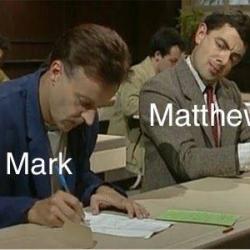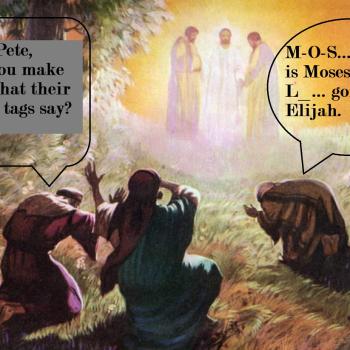Rafael kindly responded to my reply to his post, including (in a comment here) the following video, which presumably was meant to indicate that he would be tap dancing around some of the issues. 🙂
Rafael mentions a number of topics – such as whether Mark Goodacre is correct about the matter of Q – which complicate the quest of historians and scholars to make sense of these texts. I think that the following quote illustrates what is at the heart of the matter and the key difference between us:
Despite James’s confidence that in Matthew’s Sermon on the Mount, “time and again there are additional words or phrases which, when compared with Luke, seem clearly to be additions to an earlier shorter form, and reflect redactional interests of the author,” redaction critics simply cannot be sure what is original, what is secondary, or to what extent secondary changes put us in contact with an author’s real or consistent theological or ideological motivations.
Rafael is right, redaction critics cannot be sure. Historians, for that matter, cannot be sure. Few of us can be absolutely sure about anything. And a major rethinking of how we do history and how we do scholarship in the humanities in general has been underway for some time, precisely because of our awareness of this. Many of us, however, are convinced that we have other options besides the classic critical quest for certainty on the one hand, and an uncritical acceptance of what all our sources say on the other. We can be postmodern without being post-critical or uncritical. We can assess the probabilities and offer the best reconstruction we can, acknowledging our lack of absolute certainty while also trying to reach as certain conclusions as possible given the evidence we have.
That is the heart of the matter methodologically, as I see it (and I could be wrong). When it comes to the heart of the issue in terms of actual redactional tendencies in the Synoptic Gospels and our ability to identify them, I think that we can see a pattern emerging when we compare Matthew and Luke. Here are just a few well-known examples:
Beatitudes: Matthew adds “in Spirit” and “for righteousness”
Lord’s Prayer: Matthew adds “your will be done…” and “but deliver us from evil/the Evil One”
Parables: Matthew adds “You are the salt of the earth…”
Turn the other cheek: Matthew not only adds details about which cheek and being taken to court, which affect the way this material is understood, but also adds a third piece: “If someone compels you to go with him one mile…”
This seems like the same sort of thing we get in Matthew’s use of his principal source, the Gospel of Mark. Consider Peter’s confession, where Matthew adds the “Blessed are you, Simon…” material, or the apocalyptic discourse in Mark 13, where Matthew adds “in the holy place, as spoken of by the prophet Daniel.” Matthew tends to supplement his source material with explanatory comments and interpretative additions. Should we not expect that same tendency to be at work in his use of other sources – and indeed, allow that authorial tendency to guide us in our detecting of his use of other sources?
When two sources appear to have a literary relationship, whether direct or indirect, and there is regular expansion and addition by one of them, is it not the simplest explanation to treat many (not necessarily all!) of those additions precisely as authorial edits, rather than variations in the tradition that author inherited? There may be exceptions, and we should be open to identifying them. But I see no reason why such exceptions would lead us to become less confident that, in general, what we see here are Matthean additions.
And as for the fact that counter-examples can be offered, pericopes that run counter to redactional tendencies, such evidence fits what we know of redactional processes too. Take for instance Matthew 12:28 and Luke 11:20. There we find evidence of “redactional fatigue”: Matthew tends to prefer “kingdom of heaven” to “kingdom of God” and changes the latter to the former when using Mark as his source. Should we not view that general trend as an example of redaction on Matthew’s part – and his failure to always do so as evidence of the fact that redactors rarely transform their source material so thoroughly that none of its characteristics shine through even after editing?
Obviously if one thinks that Luke used Matthew, then one will understand the relationship differently. But it is the greater likelihood that Matthew added explanatory comments of these sorts than that Luke removed them systematically, combined with divergences between the two that make positing direct use of one by the other problematic, that leads most scholars to posit the existence of the Q source. Are we certain about it? No. Does uncertainty mean we should abandon it if we remain persuaded that it makes the best sense of the evidence? Not at all.
This does not mean that we should go back to the old quest to recover precise wording of sayings of Jesus. But to the extent that we prefer to get as close to the historical Jesus as possible, it remains the case that recognizing some material as secondary and redactional allows us to make a judgment about the earliest preserved form of a saying. It won’t be the exact words of Jesus, but it may get us somewhat closer than a later reworking does. And unless our aim is to not simply talk about the portraits of Jesus in our sources, but to also recognize where they seem to be reinterpreting and transforming him, then we are no longer doing critical historical study. Our failure to achieve certainty, and our inability to achieve certainty, are no excuse for not trying to be as certain as we can.
So is Rafael wrong? I obviously cannot be certain. But I think it is probable. 🙂












